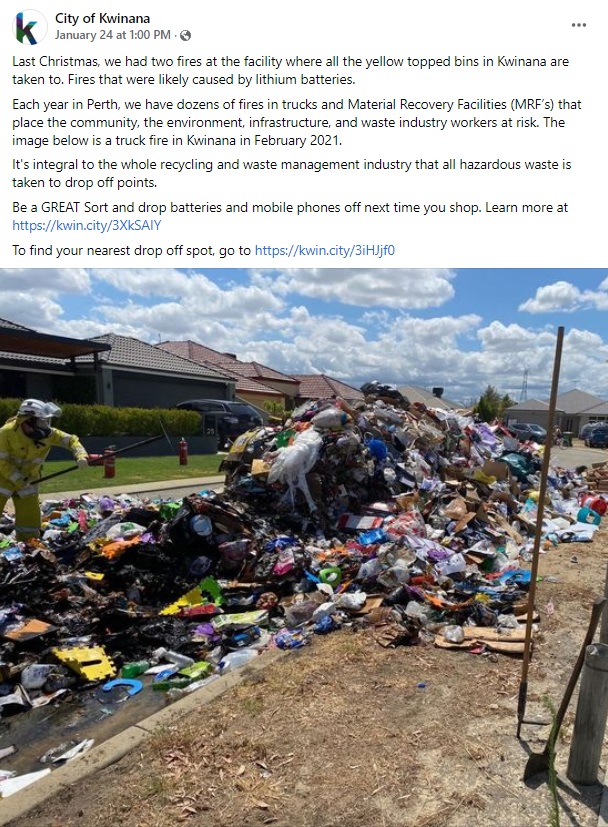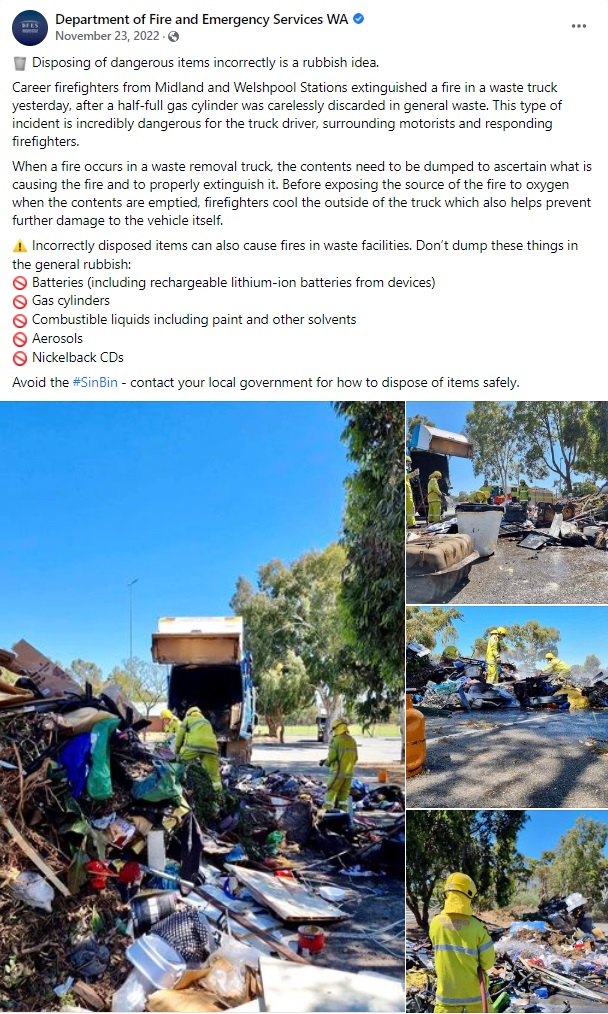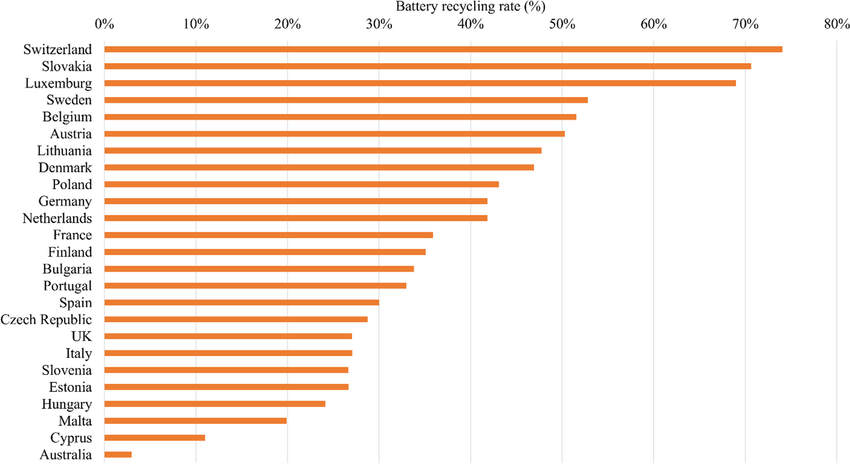“When we think about the journey our rubbish goes on, from kitchen bin to the street for collection and then to waste facilities, if there’s a battery in the mix, the risk of a fire starting along the way soars.”
“When we think about the journey our rubbish goes on, from kitchen bin to the street for collection and then to waste facilities, if there’s a battery in the mix, the risk of a fire starting along the way soars.”
The waste industry is seeing a sharp increase in waste fires on garbage trucks and in waste facilities. In Australia more than 450 fires have been linked to lithium-ion batteries over the past 18 months, according to data provided by state fire departments. WA alone recorded 81 lithium-ion related fires in the last year compared to 21 in 2018, NSW recorded 180, 120 in VIC and 72 in QLD.
Many of these incidents are a direct result of waste contaminated with lithium batteries and other household batteries, which are a no go for kerbside bins.
Late on Boxing Day 2022 the Canberra suburb of Hume was rocked with news of a blaze at the local Materials Recovery Facility (MRF).
ACT Fire and Rescue chief, Matthew Mavity, said in an interview with The Guardian that an incorrectly recycled battery or vape had not been ruled out.
“Any battery … has potential chemical energy stored and that can be released if it’s damaged,” he said.

Pictured: Facebook post by the ACT Emergency Services Agency detailing the Boxing Day blaze at Hume MRF. The fire has detailed residential recycling in the ACT.
ACT transport minister Chris Steel added that the incident should serve as a wake up call for people to make sure they only placed non-hazardous recyclables in their bins.
“Unfortunately, we do see too many dangerous objects put into the recycling stream that simply shouldn’t be there,” he said.
“Things like vapes, batteries and even gas cylinders that can cause a hazard and a risk of fire.”
The destruction of the Hume MRF is a massive blow to waste management in the ACT.
Thousands of tonnes of waste that could’ve previously been recycled locally is now being transported interstate for processing.
A nationwide concern
The Hume MRF fire is far from isolated. At around the same time, two fires broke out at a facility for yellow lidded waste in Kwinana, WA.
Just like the Hume incident, the Kwinana fires are believed to be caused by lithium batteries thrown into kerbside bins.

Pictured: Facebook post by City of Kwinana reporting on the fires that broke out at the local MRF in December 2022.

Pictured: Facebook post by Department of Fire and Emergency Services WA showing firefighters battling a fire on a garbage truck in November 2022.
Since 1 January 2022, Fire and Rescue NSW crews have responded to 180 li-ion battery fires compared to just over 16 in 2021.
Up north in Queensland, discarded batteries are believed to have caused eight Brisbane City Council garbage truck fires since July 2021.
All eight incidents forced the truck drivers to dump their hot loads on suburban streets.
In an interview with the Brisbane Times, Brisbane Lord Mayor Adrian Schrinner said that household batteries that were discarded in council bins were suspected of causing the fires.
“When we think about the journey our rubbish goes on, from kitchen bin to the street for collection and then to waste facilities, if there’s a battery in the mix, the risk of a fire starting along the way soars.”
Not even landfills are safe from battery fires.
The Australian Battery Recycling Initiative (ABRI) in its Inclusion of all batteries in the Victorian landfill ban submission to the Victorian EPA mentioned reports of at least two fires in a Victorian landfill believed to have been caused by li-ion batteries.
ABRI further explained in its submission that the incidence of battery fires in landfills continue to grow and that these incidents create hazardous fumes which are a danger to both firefighters and landfill operators.
A cause for change
According to the Hazardous waste infrastructure needs and capacity assessment report by the Department of Climate Change, Energy, the Environment and Water (DCCEEW) the surge of li-ion entering the waste stream in the years to come is of particular concern.
The report estimates that waste li-ion batteries will grow by upwards of 300% each year by 2036. The result is the generation of between 100,000 to 187,000 tonnes of waste per year.
To put this into perspective, the Sydney Opera House weighs roughly 165,000 tonnes.

Source: Randell Environmental Consulting Pty Ltd & Blue Environment for the Hazardous Waste Section Department of the Environment July 2016.
Statistics by ABRI published in Waste battery disposal and recycling behavior: a study on the Australian perspective show that Australia’s battery recycling rate is still lagging behind many countries.

Pictured: Battery recycling rate in OECD countries including Australia (ABRI 2017).
The waste industry’s fight for fire safety requires concerted action to tackle Australia’s rapidly growing li-ion waste stream. This can be addressed by further developing the current battery recycling ecosystem to keep household batteries away from kerbside bins.
A nationwide effort such as this demands cooperation from the public, waste service providers and industry to support stewardship programs such as B-cycle, Australia’s official recycling scheme.
B-cycle was launched in January 2022. In its first six months of operation the scheme has collected over 900,000kg of batteries for recycling from more than 3,200 drop off points across all eight states and territories.
Safe and sustainable alternatives are also being developed by Australian companies as a long term solution to the li-ion waste problem.
Brisbane-based Redflow and Sydney-based Gelion have developed batteries with world leading zinc bromine flow technology.
Zinc-bromide batteries offer a safer and more reliable alternative to li-ion batteries. These next gen batteries also provide performance advantages over li-ion batteries by maintaining 100% state of health even after thousands of cycles.
Apart from new and emerging technologies, battery recycling education remains the waste industry’s best safeguard against waste fires.
Cleanaway provides free resources for Australians to learn how to properly discard of their batteries and other potentially hazardous household waste.
This includes information on free battery and e-waste recycling programs for residents to bring in their end of life household batteries as well as tips on handling and managing different battery types.

Pictured: Cleanaway battery recycling education poster.
We also partner with organisations such as Clean Up Australia to support hazardous waste disposal in communities across Australia and organise hazardous waste collection events with councils across the country.
Contact us to learn more about how we’re making a sustainable future possible for communities and businesses across Australia.